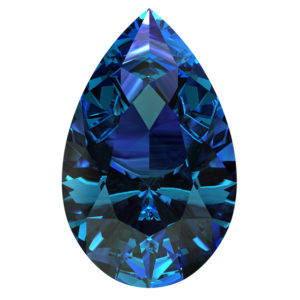 Jewelry Enhanced by Rare and Beautiful Gems
Jewelry Enhanced by Rare and Beautiful Gems
When it comes to gemstones, diamonds are practically the gold standard (pun intended). But they’re not quite as rare as you might think. There are quite a few lesser-known gemstones that you aren’t likely to find on a typical engagement ring or set of heirloom earrings. Painite, alexandrite (left), and tanzanite are just a few beautiful examples of exceptionally rare gemstones.
Painite
In 1950, Arthur C.D. Pain went to Burma (present-day Myanmar). Arthur was a mineralogist and gem dealer from Britain. During his trip, he discovered a unique, hexagonal mineral of orange-red and brownish-red hues. For decades, there were only two known faceted painite gemstones in existence. This changed in 2005, when several thousand fragments and crystals of painite were discovered. It’s still an incredibly rare gem, however, as complete crystals are few in number. Only a few crystals have been faceted to date.
Alexandrite
Alexandrite is a rare type of chrysoberyl, and it’s in the same family as emerald. The addition of traces of titanium, chromium, and iron is responsible for alexandrite’s remarkable color-changing properties. Any gemstone that shows different shades as you move it around in your hand is said to be pleochroic. Alexandrite is pleochroic, but it’s also capable of changing its colors with changes of light, regardless of the viewing angle. In natural sunlight, this exquisite gemstone is a bluish-green. In the evening, artificial light turns the gem a brilliant purplish-red hue.
Tanzanite
Geography aficionados may have already guessed that tanzanite was named after Tanzania, its country of origin. Legend has it this beautiful gem is about 1,000 times rarer than diamond. It’s debatable, but believable, given that tanzanite is only found in the foothills of Mount Kilimanjaro. The only known deposit on earth was created over 585 million years ago. Tanzanite had a difficult childhood, being born of the violent tectonic plate activity and scorching heat that also gave birth to the mountain itself.
Like alexandrite, tanzanite has an interesting color range. It’s usually described as a bluish purple or a bluish violet. The mineral structure contains a little bit of vanadium, which gives it its gorgeously rich, bluish color. The same stone could tend toward violet, however, when viewed from different directions. Like alexandrite, tanzanite is pleochroic.
Benitoite
Just like the intrepid explorer who discovered tanzanite, the original discoverer of benitoite thought that the stone was sapphire because of its brilliant blue color. But benitoite has an even more interesting property: It fluoresces under a UV light. It’s been described as a glowing blue chalk when viewed in this way. The only major deposit of benitoite is at the head waters of the San Benito River in California, although poorer quality and lesser amounts of the stone have also been found in Japan and Arkansas.
Find your one-of-a-kind gemstone at F. Silverman Jewelers
During their years of serving the Bergen County, New Jersey area, F. Silverman Jewelers has earned a reputation for superior craftsmanship and exceptional integrity. We offer an exquisite selection of gemstone jewelry and fine and fashion jewelry, suitable for every occasion. And if you don’t see something that catches your eye, our jewelers will craft a custom piece just for you. Call us or swing by our shop in Woodcliff Lake, NJ.
Additional resources for gemstone lovers:
- California Institute of Technology, Painite Visible Spectra (380 – 1100 nm), http://minerals.gps.caltech.edu/files/Visible/painite/Index.html
- Gemological Institute of America, Alexandrite Description, https://www.gia.edu/alexandrite-description


 Jewelry Enhanced by Rare and Beautiful Gems
Jewelry Enhanced by Rare and Beautiful Gems